Today’s Zero Emissions technology for tomorrow’s Zero Emissions fleet
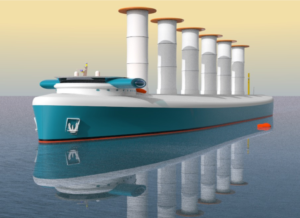
Written by Madadh MacLaine, CEO at Zero Emissions Maritime Technology Ltd
Zero Emissions Ships (ZES) are possible today. However, zero-emissions shipping is not. Why? Because although we have the technology but policy, economics, and a lack of green hydrogen stand in the way. Fortunately, the regulatory and financial landscapes are rapidly changing, putting zero emissions (ZE) vessels and green hydrogen infrastructure on the near horizon.
To be in line with IPCC recommendations of 1.5, shipping will need to be zero emissions by 2034.
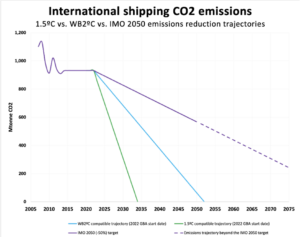
To achieve this shipping requires (1) a zero GHG fuel that can be used in existing vessels, (2) Zero Emissions Ship Technologies (ZEST) that can be retrofitted to existing vessels, and, most importantly, (3) all vessels designed from today should be zero emissions, or at the very minimum, must be zero ready. Especially given that vessels designed today, under normal circumstances, will be in service after 2050.
The good news is that we have the technology. However, much of the tech is pre-market and therefore requires a shift in the regulatory environment as well as increases in development and seed funding to become widely available.
A holistic approach
A fully Zero Emissions Ship (ZES) necessitates a holistic systems approach, incorporating many technologies that are available on the market but not currently being used in commercial shipping. In this article, I look at some of the design features and technologies required for a ZE self-fuelling water carrier that could compete in the current market with minimum negative impacts on both human and environmental factors, considering; pollution, stability, vibration, and noise.
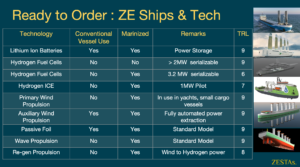
The keys to achieving zero emissions in the current environment are (1) a zero-emissions fuel, (2) efficiency measures that reduce the fuel required to propel the ship, (3) assured ZE fuel supply and (4) operational measures; speed reduction, weather, and current routing.
Fuel reducing energy efficiency features
An aero and aqua dynamic hull design will reduce drag. An air cavity in the bottom of the hull reduces friction with the added benefit of creating buoyancy when the vessel is laden. The air is released when she is in ballast reducing the need for ballast water.
Using the energy of the environment to reduce fuel
Wind, only being pre-dated by oars, is the oldest form of ZE propulsion in shipping. But modern wind propulsion technology (WPT) has more in common with The Americas Cup, airplanes, and baseball; the market-proven Flettner rotor using the same spinning Magness effect as the proverbial curveball.
Other WPTs entering the market are Airbus spin out, Airseas Seawing, pictured here on a K-Line vessel.
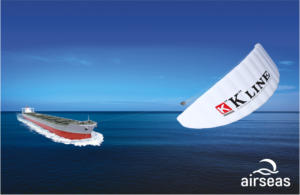
And also the suction wind, conceived in 1980 by Jacques Cousteau. Below we see the Econowind collapsible Ventifoil installed on the 3638 DWT general cargo carrier, Ankie.
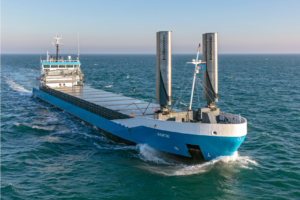
An essential design feature of the self-fuelling ZES is that, whatever the wind propulsion system used, it must be oversized to ensure excess power for onboard hydrogen production.
The ship will also use the commercially proven wave propulsion system installed in her bows.
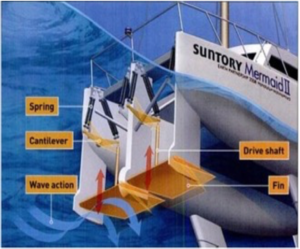
This system absorbs the energy of the wave into a rocking motion which propels the ship forward. A passive foil propulsion system will be mounted in her stern, converting the energy of the wake into forward thrust. This has the added advantage of reducing wash water impact on Coastal ecosystems.
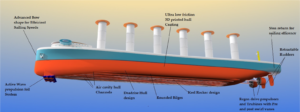
The GEPS role damping power take-in system has the double advantage of both stabilizing the ship in heavy weather and bringing the energy of the sea into the ship’s system.
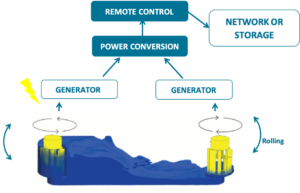
The ship will trail a water turbine when she is under wind power to bring power into the energy system. The captured renewable energy will go first to the battery bank followed by water electrolysis when the battery bank is full.
By reusing the water generated by the hydrogen fuel cells we have calculated an efficiency of ~40%.
The onboard hydrogen generation system has been proven on the Energy Observer with registered hydrogen production system efficiencies of 42%.
Both hydrogen fuel cells (HFC) and water electrolyzers, that produce hydrogen, have been used by the military in marine applications for over fifty years. Nedstack first installed an HFC in a civilian vessel in the 1980s. HFC manufacturers Nedstack, Powercell, and Ballard are all in advanced stages of designs for marinized >3 megawatts (MW) systems. ABB and HDF have plans to build 3MW power plants for ocean-going vessels based on the fuel cell power plant which was jointly developed between ABB and Ballard. Powercell is installing a ~3MW system in the 102-meter yacht pictured below.
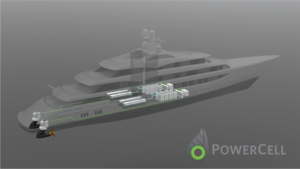
HFCs, being solid-state, can be serialized.
By the time the >80,000 DWT self-fuelling water carrier has gone through designs and is ready to build, serializable 3MW hydrogen fuel cells will be market-ready and able to provide the 21MW of required power.
Fuel is the highest cost in the bottom line of vessel operations. By virtually eliminating the cost of fuel from the bottom line, a ship can afford to operate at the reduced speeds, current and weather routing required to be self-fuelling. Although the CAPAX will be much higher than for a conventional vessel, this ship will be “bomb proof” in the coming regulatory market, holding its value past 2050.
For more detailed information, visit the Zero Emissions Ship Technology website, contact admin@zestas.org or Madadh MacLaine on Linkedin.








